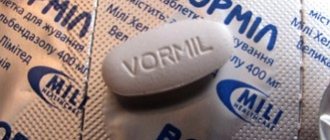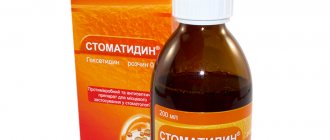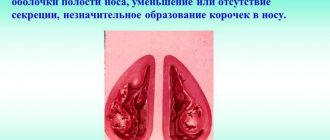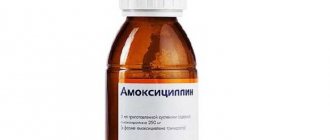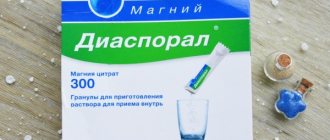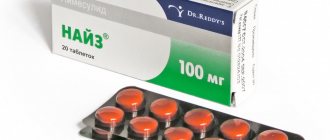Write a review
Reviews: 0
Manufacturers: Sandoz Pharma AS (Norway)
Active ingredients
- Benzathine benzylpenicillin
Disease class
- Rheumatism, unspecified
- Scarlet fever
- Erysipelas
- Syphilis, unspecified
- Open wound of an unspecified area of the body
- Surgical practice
- Acute tonsillitis, unspecified
- Inflammatory diseases of the female pelvic organs caused by syphilis (A51.4, A52.7)
Clinical and pharmacological group
- Not indicated. See instructions
Pharmacological action
- Antibacterial
- Bactericidal
Pharmacological group
- Penicillins
Pharmacotherapeutic group
Beta-lactam antibiotics, penicillins. ATX code J01C E08.
Pharmacological power.
Pharmacodynamics.
Benzathine benzylpenicillin is a long-acting beta-lactam antibiotic from the group of penicillins type G. It exhibits bactericidal activity in highly sensitive microorganisms by inhibiting the synthesis of mucopeptides in the cell wall.
Active gram-positive pathogens: Staphylococcus spp
.
(penicillinase-insoluble), Streptococcus spp
., including
Streptococcus pneumoniae
,
Corynebacterium diphtheriae
, anaerobic spore-infecting rods,
Bacillus anthracis
,
Clostridium spp
.,
Actinomyces israelii
;
gram-negative microorganisms: Neisseria gonorrhoeae
,
Neisseria meningitidis
, as well as
Treponema spp
.
Before taking the drug, resistant strains of Staphylococcus spp
., which produce penicillinase, which is called benzylpenicillin.
In connection with the treatment, the drug is used for the treatment of infections caused by Streptococcus spp
.
i Treponema pallidum
.
Pharmacokinetics.
When administered internally, benzathine benzylpenicyline is completely absorbed from the injection site, ensuring prolonged action.
The maximum concentration in serum is achieved 12-24 years after injection. A three-week dosing period will ensure a stable and trival concentration of the drug in the blood: on the 14th dose, after administering 2,400,000 IU of the drug, the concentration in the blood serum becomes 0.12 mcg/ml. The level of binding to blood plasma proteins becomes approximately 55%.
Benzathine benzylpenicyline penetrates the placental barrier in a small amount, as well as breast milk. Biotransformation of the drug is insignificant. It is important to show off your unchangeable appearance; in 8 dB up to 33% of the administered dose is excreted.
Side effects of the drug Retarpen
allergic reactions: urticaria, fever, joint pain, angioedema, exfoliative dermatitis, erythema multiforme, difficulty breathing, anaphylaxis. When treating syphilis, the Jarisch-Herxheimer reaction may develop due to the release of endotoxins. From the system, hematopoiesis: transient anemia, leukopenia, thrombocytopenia. From the digestive system: stomatitis, glossitis, nausea, vomiting, diarrhea, candidiasis; Cases of the development of pseudomembranous colitis have been described when using benzathine benzylpenicillin. Other side effects rarely noted: moderate transient increase in serum transaminases, acute interstitial nephritis. With prolonged antibiotic therapy, it is necessary to pay attention to the possibility of developing superinfection with persistent microorganisms and fungi. The use of β-lactam antibiotics in high doses, especially in cases of liver failure, can cause the development of encephalopathy (confusion, impaired movement, convulsions).
Showing
Treatment of infections caused by drug-sensitive microorganisms:
- acute tonsillitis;
- scarlatini;
- beshikha (chronic), erisipeloid;
- Infected wounds and wounds from bites;
- syphilis and other illnesses caused by treponemes (yaws, endemic syphilis, pinta).
Prevention:
- rheumatic illnesses (chorea, rheumatic carditis);
- poststreptococcal glomerulonephritis;
- scarlet fever (after contact with illness);
- beshikhi;
- syphilis (after contact with the disease).
Contraindicated.
Hypersensitivity to any component of the drug, beta-lactam antibiotics (penicillins and carbapenems), soy, peanuts. History of hypersensitivity to cephalosporins (5-10% of cases). For treatment of illnesses that require high concentrations of penicillin in the blood serum and cerebrospinal fluid (severe pneumonia, empyema, sepsis, pericarditis, meningitis, peritonitis, arthritis, congenital neurosyphilis), following the use of hydrogenated sodium and benzylpenicillin. Kropivyanka, polynoses, severe allergic reactions and a history of bronchial asthma.
Indications for use of the drug Retarpen
Treatment of infections caused by microorganisms sensitive to the drug:
- syphilis and other diseases caused by treponemes (yaws, pinta);
- acute tonsillitis;
- scarlet fever;
- erysipelas, erysipiloid;
- infected wounds and bite wounds.
Prevention of infections caused by microorganisms sensitive to the drug:
- rheumatic fever (chorea, rheumatic heart disease);
- poststreptococcal glomerulonephritis;
- syphilis (after contact with a patient);
- scarlet fever (after contact with a sick person);
- recurrence of erysipelas;
- infections during tonsillectomy or after tooth extraction.
Interactions with other medicinal drugs and other types of interactions
Penicillin drugs, which may have a bactericidal effect, cannot be combined with bacteriostatic antibiotics. A combination with other antibiotics is only possible if a synergistic effect or any additional effect can be achieved. Other components of the therapeutic combination are responsible for administration at a higher dose (the dose of the greater toxic component may be changed if a synergistic effect is indicated).
The mother is aware of the possibility of competitive inhibition of the process of elimination from the body during one-hour infusion of benzathine benzylpenicyline with anti-inflammatory, anti-rheumatic and antipyretic agents (indomethacin, phenylbutazone, salicylates at high doses) or probenecid.
Immediate administration of methotrexate will alter the elimination of the remaining substance and may lead to increased toxicity. The combination of Retarpen and methotrexate is not recommended.
With one-hour stagnation, the effectiveness of indirect anticoagulants increases. When taking oral anticoagulants, the influx of antivitamins may increase and the risk of bleeding may occur. It is recommended to periodically determine the level of the International Normalized Index (INI) and, therefore, correct the concentration of antivitamin drugs immediately after treatment with Retarpen.
Congestion of benzathine benzylpenicillin may, in some cases, cause a decrease in the effectiveness of oral contraceptives.
To prevent unnecessary chemical reactions, the Retarpen suspension should not be mixed with other injectable agents.
Benzathine benzylpenicyline should be administered with caution to patients who are withdrawing digoxin, which may lead to a risk of bradycardia when left untreated for one hour.
Alopurinol promotes the risk of developing allergic reactions (skin sores).
Aspirin, probenecid, thiazide diuretics, furosemide, etacrynic acid increase the period of dosing of benzylpenicillin, increasing its concentration in blood plasma, as a result of which the risk of development of its toxicity increases oi dіi way flows into the tubular secretion of nirok.
Inflow to laboratory research:
- Positive direct Coombs test (≥ 1% to < 10%) in patients, so administer 10,000,000 MO (equivalent to 6 g) benzylpenicyline or more as needed. After taking Retarpen, the direct antiglobulin test may become positive for 6 to 8 days;
- Possible hibi-positive result of the test for the detection of protein in the sample during the precipitation reaction (sulfosalicylic acid, trichlorocic acid), by the Folin-Ciocalteu-Lourie method, by the biuret method. Follow other methods for identifying protein in the crop;
- Possible hibno-positive result of the test for the detection of amino acids in the sample (ninhydrin method);
- penicillin binds to albumin. When using electrophoresis to produce albumin, pseudobisalbuminemia can be avoided;
- Possible hibno-positive result of testing glucose and urobilinogen by a non-enzymatic method;
- with the determination of 17-ketosteroids in the test (using the Zimmermann reaction), it is possible to remove the protective values.
Features of stagnation.
The drug must be taken only internally. Before starting treatment with Retarpen, patients should be checked for tolerance to the drug. Over-sensitivity (5-10%) is possible in cases of hypersensitivity to other beta-lactam antibiotics (including cephalosporins, imepenema).
Severe and sometimes fatal episodes of hypersensitivity (anaphylactic reaction) were observed in patients who were on penicillin therapy. Such reactions occur more often in patients with a known history of severe allergic reactions. To treat the symptoms of an anaphylactic reaction, the following may be necessary: continuous administration of adrenaline, steroids (internally) and simple therapy for respiratory failure. With special care, administer the drug to patients with hay fever, urticaria and other allergic illnesses. The drug is not recommended for the treatment of patients with acute lymphocytic leukemia or infectious mononucleosis associated with an increased risk of erythematous rashes on the skin. In case of severe dysfunction, even large doses of penicillin can cause cerebral damage, depending on who.
If you are taking this drug and suffer from diabetes, you must take a reduced dose of Retarpen from the meat depot.
Use caution in case of allergic diabetes, narcotic deficiency, impaired liver function, dermatomycoses (possible para-allergic reactions between penicillins and metabolites of dermatophytes).
It is imperative that medical care be taken of the patient, especially in the first year after administration, severe allergic reactions of a non-toxic type may occur after the first administration.
When treated for syphilis, a Jarisch-Herxheimer reaction may occur as a result of the bactericidal action of penicillin on the day. From 2 to 12 years after administration the following may occur: headache, fever, sweating, nausea, myalgia, arthralgia, fatigue, tachycardia, increased arterial pressure with further hypotension. These symptoms disappear after 10 to 12 years. Patients must be informed about the transitional complications of antibacterial therapy.
To suppress or alleviate the Jarisch-Herxheimer reaction during the first administration of Retarpen, administer 50 mg of prednisolone or its equivalent. In patients with syphilis at a stage that manifests itself in the cardiovascular system, blood vessels and meninges, the Jarisch-Herxheimer reaction can be prevented by taking prednisolone 50 mg per dose or equivalent sterol stretch 1-2 lengths.
People with epilepsy may have thickened skin, which may benefit from ice packs.
With episodic intravascular administration of Retarpen, symptoms of depression, fear, anxiety, possible hallucinations, shock, confusion, restlessness, development of cyanosis, tachycardia, rupture may occur. motor skills ( Hoigne's
). Symptoms disappear over time. In the event of a severe reaction, the administration of sedatives is indicated.
In case of a sudden intraarterial injection, complications may develop, for example, vessel occlusion, thrombosis, gangrene. Precursors of this include the appearance of pale plaques on the skin of the sow.
Repeated injections may cause tissue damage and increased vascularization.
When treating sexually transmitted diseases, before starting therapy, it is necessary to carry out an examination under a dark field microscope, if there is a suspicion of syphilis. In addition, it is necessary to conduct serological studies over a period of 4 months. To treat congenital syphilis, it is necessary to conduct an investigation of the cerebrospinal region before starting therapy. In case of impossibility of eliminating neurological symptoms in patients with congenital syphilis, it is recommended to use drug forms to replace penicillin, which will increase the concentration of benzylpenicilin in cerebrospinal region. Once you get sick, and yourself - severe pneumonia, empyes, sepsis, meningitis or peritonitis, which will require high concentrations of penicillin in the blood serum, treatment should begin after stagnation of water. and sodium salt of benzylpenicyline.
After continued treatment with the drug, periodic monitoring of blood and neurological function indicators is recommended. Also, take into account the possibility of the development of resistant microorganisms and fungi.
In cases where severe and persistent diarrhea is present, there is a risk of developing pseudomembranous colitis caused by stagnation of antibiotics. In such cases, it is important to immediately begin administering the drug and initiate appropriate therapy. In this case, drugs that suppress peristalsis are contraindicated.
Suspension during pregnancy or breastfeeding.
Vaginism.
Benzathine benzylpenicyline crosses the placenta. The drug can be frozen after a thorough assessment of bark/rizik.
Goddamn breastfeeding.
Benzathine benzylpenicyline passes into breast milk in small amounts. The concentration in milk can range from 2% to 15% of the concentration in maternal plasma. It was not necessary to be aware of the possibility of undesirable reactions in animals, due to possible sensitization and interference with intestinal flora. Breastfeeding should be taken in cases of diarrhea, candidiasis and sore throat in children.
They don’t speak, because they are on a combined diet, so for an hour, the mother’s bathing with Retarpen should be transferred to the children’s diet. Breast bathing can be repeated 24 years after breastfeeding.
Oral contraceptives
. As with other antibiotics, the effectiveness of oral contraceptives may be reduced in some cases. It is recommended to use additional forms of contraception.
Impact on reproductive function.
Humans have not carried out extensive research on the reproductive function.
This is due to the fluidity of the reaction during treatment with vehicles or other mechanisms.
Due to the possibility of serious adverse reactions (such as anaphylactic shock and anaphylactoid reactions) should be avoided during treatment by motor vehicles or robots with other mechanisms.
Method of congestion and dosage.
Before administration, it is necessary to obtain a history of drug tolerance from the patient and conduct a preliminary internal test to determine his tolerance.
Retarpen zastosovuvat only internally!
To prepare a suspension, add 5 ml of water for injection to the bottle. Apply the freshly prepared suspension vigorously for 20 seconds and inject the vicorist head with a thickness of 0.9 mm. Retarpen is injected into the upper quadrant of the squamous pulp. To introduce the drug, it is necessary to inject the head perpendicularly to the surface of the skin with a sharp stroke, not including the presence of large vessels. If, when the drug is administered, there may be aspiration of blood or pain, the injection is followed by pinching. The drug is administered as quickly as possible under a low pressure. You cannot rub the injection site after administration. If repeated injections are necessary, change the injection location. It is necessary to carry out aspiration immediately before administering the drug in order to avoid scratching the heads of the blood vessel. Inject no more than 5 ml of suspension into one place at a time.
Treatment for syphilis.
Primary syphilis. One-time 2,400,000 MO for Retarpen, distributed over the 2nd month of administration.
Secondary syphilis. 2,400,000 MO for Retarpen at the 2nd month of introduction.
If clinical manifestations are repeated or laboratory results are no longer positive, repeat the investigation.
Late syphilis (seropositive latent syphilis). 2,400,000–4,800,000 MO for a stretch of 3-5 lengths.
The celebration of yaws.
1,200,000 – 2,400,000 MO one-time. Persons who have little contact with the sick or those with a latent form of infection are given half the dose.
Likuvannya pinti.
2,400,000 MO to Retarpen one-time.
Treatment of other infections caused by microorganisms sensitive to the drug (acute tonsillitis, scarlet fever, beshiha, erysipeloid, infected wounds and wounds such as bites).
2,400,000 MO Retarpenu shotizhnya.
Prevention of rheumatic fever and rheumatic endocarditis, chorea, post-streptococcal glomerulonephritis and beshiha.
1,200,000 – 2,400,000 MO to Retarpen 1 time per 4 years.
The effectiveness of prevention is determined by the doctor individually.
Prevention of scarlet fever especially when there is little contact with the sick.
2,400,000 MO to Retarpen one-time.
In case of streptococcal illnesses, the course of treatment may be no less than 10 days to relieve complications. As a rule, one injection of Retarpen 2,400,000 MO is sufficient.
Particular categories of patients.
Patients with impaired nirofunction.
| Dosage of Retarpen depends on creatinine clearance | |||
| Creatinine clearance, ml/xv | 100–60 | 50–10 | < 10 |
| Blood serum creatinine in mg% | 0,8–1,5 | 1,5–8,0 | 15 |
| Part of the initial dose | 100 % | 75 % | 20-50% (max. 1,000,000–3,000,000 MO/production) |
| Administration interval | 1 introduction | 1 introduction | Share on 2-3 administrations |
Patients who are on hemodialysis.
Benzathine benzylpenicillin can be removed by hemodialysis. There is no sufficient data on the use of dialysis against benzathine benzylpenicyline in blood plasma.
Patients with impaired liver function.
In case of severely impaired liver function, there may be a slight delay in the degradation and excretion of penicillins.
Children.
The drug should not be given to children.
Special instructions for the use of the drug Retarpen
When prescribing the drug to patients with diabetes, it is necessary to take into account the prolonged absorption of Retarpen from the muscle depot. The drug should be prescribed with caution if you are prone to allergic reactions, pseudomembranous colitis, or liver failure. If allergic reactions occur, therapy should be discontinued. In these cases, patients are prescribed adrenaline, antihistamines and corticosteroids. With accidental intravascular administration of Retarpen, a feeling of depression, anxiety and visual disturbances (Hoigne's syndrome) may be noted. For sexually transmitted diseases with suspected syphilis, microscopic and serological studies must be carried out before starting therapy, and then for 4 months. During pregnancy and breastfeeding. There is no data on the embryotoxic, teratogenic and mutagenic effects of Retarpen. Benzathine benzylpenicillin passes into breast milk, so breastfeeding should be discontinued during treatment.
Overdose
Ingestion of high doses of beta-lactam antibiotics, especially in liver failure, can cause the development of encephalopathy (confusion of speech, impaired mental health). Penicillins in extremely high doses can cause neuromuscular restlessness and seizures, similar to epileptic ones. Potentially in case of overdose, possible gastrointestinal symptoms and electrolyte imbalance.
Likuvannya:
symptomatic and supportive therapy, hemodialysis. The specific antidote is unknown.
Interactions of the drug Retarpen
It is possible to develop competitive inhibition of excretion from the body with simultaneous use of Retarpen with anti-inflammatory, antirheumatic and antipyretic drugs (indomethacin, phenylbutazone and salicylates). Penicillin drugs that have a bactericidal effect should not be used in combination with bacteriostatic antibiotics. Combination with other antibiotics is possible when a synergistic effect or any additional effect is possible. The individual components of the therapeutic combination should be prescribed at full dose (the dose of the more toxic component may be reduced if a synergistic effect is shown). Increases the effectiveness of indirect anticoagulants (inhibits intestinal microflora, reduces the prothrombin index; reduces the effectiveness of oral contraceptives, drugs that metabolize para-aminobenzoic acid, ethinyl estradiol - the risk of breakthrough bleeding. Alopurinol increases the risk of allergic reactions (skin rashes).
Release form and composition
Retarpen is available in the form of a powder for the preparation of a suspension for intramuscular administration of prolonged action: slightly agglomerating, white or yellowish-white in color (Retarpen 1200000 IU - ~ 1.14 g in colorless glass bottles with a capacity of 5 ml, in a cardboard pack of 1 or 100 ( for hospitals) bottles; Retarpen 2400000 IU - ~ 2.27 g each in colorless glass bottles with a capacity of 15 ml, in a cardboard pack of 1 or 50 (for hospitals) bottles).
1 bottle contains:
- Active ingredient: benzathine benzylpenicillin – 1.0256 g or 2.0513 g;
- Auxiliary components: povidone, simethicone, sodium citrate buffer pH 7.0, mannitol.
